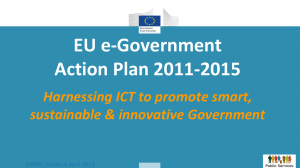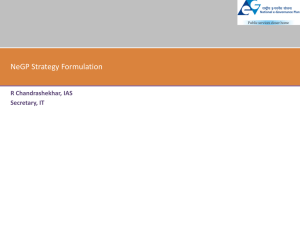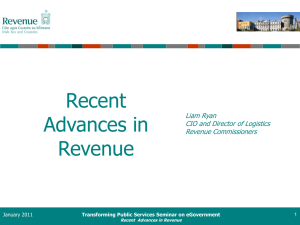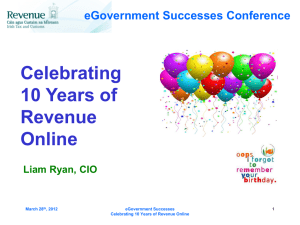Strategies for Implementing the Nigerian e
advertisement
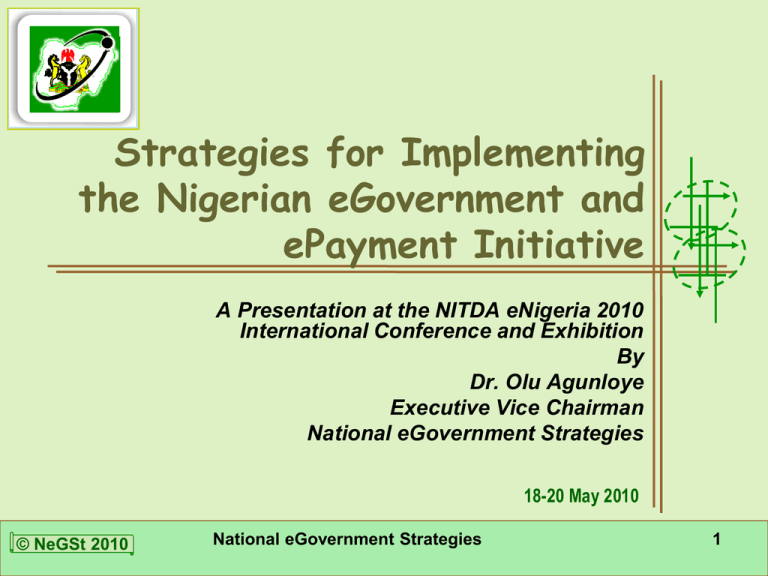
Strategies for Implementing the Nigerian eGovernment and ePayment Initiative A Presentation at the NITDA eNigeria 2010 International Conference and Exhibition By Dr. Olu Agunloye Executive Vice Chairman National eGovernment Strategies 18-20 May 2010 © NeGSt 2010 National eGovernment Strategies 1 Presentation Layout I Introduction II Leveraging eGovernment III Implementing eGovernment IV ePayment within eGovernment V Delivering on eGovernment © NeGSt 2010 National eGovernment Strategies 2 Part I Introduction … Implications of National Vision 20-2020 …. © NeGSt 2010 National 3 eGovernment The Real Issues 1. Nigeria takes a stand on National Vision 20-2020 2. Natural resources alone may not achieve it 3. Human resources and systems’ efficiency will play a significant role 4. This is about National Competitiveness 5. It is about overtaking other countries 6. The other countries are not standing still © NeGSt 2010 National eGovernment Strategies 4 Implications of Vision 20-2020 in 2007 Compare with other nations Rank Country GDP 20 Indonesia 432,944 21 Switzerland 423,938 22 Poland 420,284 23 Norway 391,498 24 Taiwan 383,307 25 S/Arabia 376,029 26 Austria 373,943 27 Greece 314,615 28 Denmark 311,905 29 Iran 294,089 30 South Africa 282,630 GDP (nominal) – 2007 Source: International Monetary Fund 31 32 33 34 35 36 — 37 38 39 40 41 Argentina Ireland Thailand Finland Venezuela Portugal Hong Kong (China) UAE Malaysia Czech Republic Colombia Nigeria It is about overtaking other nations © NeGSt 2010 National eGovernment Strategies 259,999 258,574 245,659 245,013 236,390 223,303 206,707 192,603 186,482 175,309 171,607 166,778 The Countries to Overtake as at 2009 GDP (nominal) – 2009 Compare with other nations Rank Country Source: International Monetary Fund GDP 31 Denmark 309,252 20 Belgium 470,400 32 South Africa 287,219 21 Poland 430,197 33 Thailand 263,889 22 Sweden 405,440 34 Finland 238,128 23 Norway 382,983 35 United Arab Emirates 229,971 24 Austria 381,880 36 Colombia 228,836 25 Taiwan, R.O.C. 378,969 37 Portugal 227,855 26 Saudi Arabia 369,671 38 Ireland 227,781 27 Venezuela 337,295 Hong Kong 210,731 28 Greece 330,780 39 Czech Republic 194,828 29 Iran 330,461 40 Israel 194,825 30 Argentina 310,065 41 Malaysia 191,463 42 Egypt 187,954 43 Singapore 177,132 44 Nigeria 173,428 © NeGSt 2010 - National eGovernment Strategies 6 Faring on National Vision 20-2020 Year Countries to overtake 2007 2008 2009 21 19 24 2010 ? © NeGSt 2010 National eGovernment Strategies 7 Part II Leveraging eGovernment … the imperatives of eGovernment in context of National Aspirations …. © NeGSt 2010 National 8 eGovernment Grasping the Basics for the Vision- I It is important that Nigeria should be committed to: • the goal of being one of the 20 biggest economies in the world • the implications of being one of the 20 most dynamic and competitive knowledge-based economies in the world by 2020 • the requirements of national competitiveness for sustainable economic growth © NeGSt 2010 National eGovernment Strategies 9 Grasping the Basics for the Vision II Knowledge Based Economy (KBE) is an Economy driven by generation, processing and utilization of knowledge as the major input for higher productivity and wealth creation. Critical Pillars of KBE: Information and Communications Technology, (ICT) (Key Enabler) Science, Technology and Innovation (STI) (Determinant of Sustainability & Competitiveness) Human Resource Development, (HRD); (Nucleus) - Zuru (2010) © NeGSt 2010 National eGovernment Strategies 10 Towards a Competitive Government • Governments are coming under increasing pressure to promote competitiveness as well as become competitive themselves • They need capacity to steadily improve government quality, and to always strive to serve the public more efficiently and effectively • Competitive government is one that provides services most people and businesses want at affordable tax rates • Competitive government is one of the fundamentals for a competitive economy © NeGSt 2010 National eGovernment Strategies 11 Path to National Competitiveness • Productivity Growth makes it possible for an expansion of output, not just without concomitant increases in inputs, but with important reductions in hours worked over the medium term • Productivity Growth makes possible a sustained rise in real incomes leading to Economic Growth • Injection of ICT is a major driver of Productivity Growth • Efficient and responsive Public Service is essential for Productivity Growth • eGovernment is a key factor for increasing competitiveness and generating a responsive public service Therefore, eGovernment propels productivity growth which is needed to achieve sustained economic growth © NeGSt 2010 National eGovernment Strategies 12 eGovernment as Driver for Nigeria’s Vision Vision 20-2020 National Competitiveness Economic Growth Productivity Growth Public Sector Efficiency eGovernment © NeGSt 2010 National eGovernment Strategies 13 Part III Implementing eGovernment … evoking novel Public Private Partnership s …. © NeGSt 2010 14 Placing eGovernment in Perspectives • eGovernment is about Integration of MDAs & enabling Citizen-Centric Interaction • eGovernment is about Good Governance • It is about the strategies, processes and systems in the provision of citizen-centric Services • It is multi-dimensional and multi-disciplinary • It is about new leaderships and partnerships to build an eNation © NeGSt 2010 15 Nigeria’s March to eGovernment The background to the eGovernment Initiative in Nigeria: • March 2001: National IT Policy • March 2003: National Information Technology Development Agency, NITDA • March 2004: National eGovernment Strategies, NeGSt as a Special Purpose Vehicle for eGovernment thru Public Private Partnership © NeGSt 2010 National eGovernment Strategies 16 Mandate for eGovernment NITDA has the Mandate for electronic Government under NITDA ACT 2007 NITDA has regulatory powers for eGovernment and other IT development and standardisation © NeGSt 2010 National eGovernment Strategies Mandate of NeGSt (Section 6, NITDA ACT 2007) NeGSt is a subsidiary of NITDA created through Public Private Partnership, as Special Purpose Vehicle for eGovernment standards and implementation platform © NeGSt 2010 National eGovernment Strategies 18 Roles of NeGSt Develop standards and guidelines for eGovernment implementation on behalf of NITDA Build and maintain a one-stop platform for the integration and implementation of eGovernment services on behalf of NITDA Perform any other functions as may be assigned by NITDA in relation to e-government © NeGSt 2010 National eGovernment Strategies 19 Nigerian PPP Model for eGovernment • The Nigerian PPP model for implementing eGovernment leverages on Government’s economic and civil service reform processes which include deliberate programme to nurture the private sector. • There are three prominent players in this model - Government, Private Sector and the Citizen. © NeGSt 2010 National eGovernment Strategies 20 Explaining the NeGSt PPP Model • Public and Private Sectors invest in Reform Agenda and eCommerce respectively • Public Sector makes ‘profits’ in terms of savings from efficiency, blockage of wastes & reduction of corruption etc • Private Sector makes profits from eCommerce • Public and Private Sectors collaborate to evolve eGovernment processes to sustain the process of making “profits” • Collaboration of Public and Private Sectors leads to provision of Improved Services to Citizens • NeGSt drives model to generate branded better values for citizens from technical solutions, private sector funds and public sector data © NeGSt 2010 National eGovernment Strategies 21 The Public Private Partnership Model for eGovernment Public & Private Sectors collabora te gainfully to satisfy the Citizens Government Gains Govt carries out reforms to provide better services and good governance Public Sector Reforms eGovernment Electronic Commerce Profits Private Sector Improved Services Citizens Citizens demand from Govt type of services they enjoy from the private sector Govt teams up with Private Sector for National Development © NeGSt 2010 22 PPPs for eGovernment are Strategic • It is not only about funding, PPP provides an arrangement whereby private investors not only share gross returns or/and profit with Government, but also share losses and risks involved • To mitigate against losses, Private Partners get involved with training of Government staff, general capacity building within the Agencies and transformation of entire Agency. • To ensure sustainability, the terms of the PPPs stipulate that the shares of the Government Agencies in the profits be ploughed back for capacity building for staff and enhancement of back-office resources within the Agencies © NeGSt 2010 National eGovernment Strategies 23 Extracting Implementation from the eGovt Model… … a recap of the eGovernment Model is needed here The NeGSt Model FGN GAINS eREFORM PPP eCOMMERCE PROFIT © NeGSt 2010 eServices eGOVT Private Sector National eGovernment Strategies IMPROVED SERVICES Citizens 24 NeGSt Values eGovernment PPP Platforms Programmes Projects Products Partnerships Private Solutions Sector Funds Public Sector Data Technical Mechanism of Partnership Operations- II eServices © NeGSt 2010 National eGovernment Strategies 25 Building Blocks for eGovernment Partnerships 1. Unique Model with three component parts: (a) Strategic Partner - to offer eStrategy, (b) IT Agency- to set and monitor policy and mentor project, (c) Private Sector Investor- to provide funds, discipline & drive. 2. Special Purpose Vehicle National eGovernment Strategies, NeGSt to facilitate eGovernment programmes at all levels 3. Partnerships - single or multiple or nested partnerships with solutions providers, infrastructure providers and funds providers. © NeGSt 2010 National eGovernment Strategies 26 © NeGSt 2010 National eGovernment Strategies Standards and Guidelines (Integration & Interoperability) Process Re-engineering (Leadership & Commitment) Vision New Organisational Model Back-Office Reorganisation Governance Common Gateway/ Central Platform (for Shared Services) Change Management & Capacity Building Pillars of eGovernment Partnerships eStrategy NeGSted Partnerships for eGovernment 27 Key Partners for eGovt Implementation Project Owner COMMITMENT LEADERSHIP Project Financier FUNDING FINANCIAL MANAGEMENT Project Operator PROCESS ANALYSIS SYSTEM DESIGN, CONFIGURATION AND BUILD INTEGRATION & Project Integrator INTEROPERABILITY © NeGSt 2010 SHARED SERVICES National eGovernment Strategies PUBLIC SECTOR DATA FINANCIAL DISCIPLINE APPLICATIONS & eSERVICES CHANGE MGT, CAPACITY BUILDING & COMPLIANCE HARDWARE PROJECT MGT 28 End Product: The eGovernment platform for new Nigeria Applications Shared Services eApp1 eApp2 PKI eApp N Govt Business GovtNets ePayment-eNaira GovtApps Interoperability eProjects eGovt Platform eAuthentication Change Management Other Governments eMilitary MDA-01 eState & eLGA MDA-02 eLegislature eJudiciary Special Agencies CBN © NeGSt 2010 MDA-K Special Governments oNSA ICPC EFCC National eGovernment Strategies FRSC Police 29 Part IV ePayment with eGovernment … situating ePayment as a shared service within eGovernment platform…. © NeGSt 2010 30 What is ePayment? • In a nutshell: ePayment is a cluster of technologies and processes that allow the execution of financial transactions by electronic messages without the necessity of a paper instrument of exchange. The message substitutes for an exchange currency or a signed cheque. • “It means automated processing of transactions, through Information Technology, for the finality of payment without recourse to physical evidencing …” . . . Ibrahim Dankwambo, OON - Accountant General of the Federation © NeGSt 2010 National eGovernment Strategies 31 The Presidential Order on ePayment 1. Oct 2008 Circular directed all government payments (recurrent/capital) through electronic payment with effect from 1 January, 2009. 2. This means that mandates from MDAs will cause banks to make direct payments electronically to: a. b. c. d. Employees Contractors Consultants Creditors and other Service Providers © NeGSt 2010 National eGovernment Strategies 32 Technical Implications of the Presidential Order The ePayment order is expected to leverage on: • Existing IT infrastructure of the CBN, other commercial banks and the Switches • Existing Communication infrastructure or backbone • Existing infrastructure at the MDAs • National Platform for eGovt Integration, shared services & interoperability • Adequate Human Capacity at the MDAs © NeGSt 2010 National eGovernment Strategies 33 But Are We Ready? • To Manage and Mitigate the Risks? • To Manage and Mitigate the Security Challenges? • To meet up with the Technology Challenge? – at the banks, MDAs • To carry out end-to-end processing? – common platform, standards, interoperability, PKI, Legal and Regulatory frameworks © NeGSt 2010 National eGovernment Strategies 34 ANSWER: We are Ready to start: Salient Points in respect of ePayment We are ready but must note: 1. For every payment, there is a reason and associated procedure which we may call “procurement process” for convenience. 2. Payment is a service common to all MDAs irrespective of their core functions 3. ePayment is one of the shared services on eGovernment platform 4. There is need for implementation in phases © NeGSt 2010 National eGovernment Strategies 35 Embedding ePayment within eGovernment Platform 1. eGovt platform, also known as eNigeria Platform, is an integration platform for eServices 2. The Platform has eProcurement as shared Service 3. .ePayment is one of the shared services on the Platform 4. Payment gateway, also known as eNigeria Payment Platform or eNaira Platform is embedded in the eGovt Platform to facilitate ePayment for eGovt transactions 5. Other Platforms - eLGA, eRegistration etc are on the eNigeria Platform © NeGSt 2010 Interoperable Platforms on eNigeria eProcurement eNaira Platform Platform eRegistration Platform eNigeria eLGA Platform Platform eNigeria Platform eLGA Platform eRegistration Platform eProcurement Platform eNaira Platform 36 The eNigeria Payment Platform eProcurement eApplications mobileNaira MDAs 23 ISW Banks Pre-Activated eN Cards/ePINs eNgPP Pre-Activated Cash Cards eNaira Platform Other Switches MDA Networks Contractors Clients/Citizens Payment Tool X © NeGSt 2010 CBN eMonitoring National eGovernment Strategies 37 37 eNgPP Architecture Contractors MDAs eApps ePay Switches Monitor eGovernment, eCommerce & eServices COLLECTION LAYER Core of the PaymentLAYER Platform PROCESSING DISTRIBUTION LAYER eNigeria Platform with PKI National eGovernment Strategies © NeGSt 2010 LEGAL & POLICY STANDARDS & SECURITY Citizens 38 A General Representation of PKI Root Certificate Authority (RCA) Registration Authority (RA) Certificate Authority (CA) Signed Certificate Policy & Certificate Practice Certificate Statement Certificate Signed holder Message Relying Party Private Public Key Key © NeGSt 2010 National eGovernment Strategies 39 Part V Delivering on eGovernment … how far on eGovernment programme …. © NeGSt 2010 40 Summary of eGovernment Implementation Consensus Building • Presidency, Ministers, Associations, NGOs etc • Stakeholders, Alliance Partners of Funds/Solutions providers Briefing • Presidential, Ministerial, Inter-ministerial, NITDA, Board Strategies • Viable PPP Model for eGovernment • Quick Win Model with Multiple Partnerships • 18-Month Buy-In Tours of Government Agencies Projects • Nigerian eGovernment Interoperability Framework, Ng-eGIF • eReadiness Capacity Building in 178 MDAs • Roll-Out of eGovernment Platform with shared services • Roll-out of Vertical eSolutions thru PPP and SaaS* models * SaaS – Software as a Service © NeGSt 2010 National eGovernment Strategies 41 Highlights of Accomplishments I 1. 2. 3. 4. 5. Private Sector Investment in eGovernment National eGovt Platform: May ‘05 eRegistration sub-Platform: May 2006 eForm for all MDAs: August 2006 eReadiness Capacity Building for MDAs: Oct 2006 6. ePayment Primer for MDAs: Oct 2006 7. eImmigration sub-platform: March ’07 © NeGSt 2010 National eGovernment Strategies 42 Highlights of Accomplishments III 8. 9. 10. 11. 12. 13. eNYSC sub-Platform: Sept 2007 eGovt Interoperability Framework (with World Bank) - June ’08 eSUBEB (eEducation) sub-platform- Dec ’08 Consensus Building on Framework for eGovernment (with UN)- Feb ’09 eLGA Sub-platform & National Summit – Feb ‘09 eProcurement Platform - Aug ‘09 © NeGSt 2010 National eGovernment Strategies 43 Chief Concerns for eGovernment Five Factors which determine successful implementation of eGovernment programmes in Nigeria and areas with similarly low resources and capacities: (a) Government (b) Access to PC & Internet (including energy factor) (c) Contents of eGovernment solutions (d) Partnerships (e) Human Resources © NeGSt 2010 National eGovernment Strategies 44 Prerequisite for Sustainability 1. Institutional Framework (including National Advisory Committee on eGovernment, National eGovernment Steering Committee, National eGovernment Working Group) 2. Acquisition of Basic ICT Skills and eReadiness Capacity Building for MDAs 3. Implementing Minimum Standards & Guidelines for eGovernment in MDAs 4. High Level eReadiness Capacity Building Workshops for top Government Functionaries © NeGSt 2010 National eGovernment Strategies 45 Authentication Document Reference: eN/2010/EVC/1805/NITDA Contact: olu.agunloye@negst.com.ng © NeGSt 2010 National eGovernment Strategies 46

